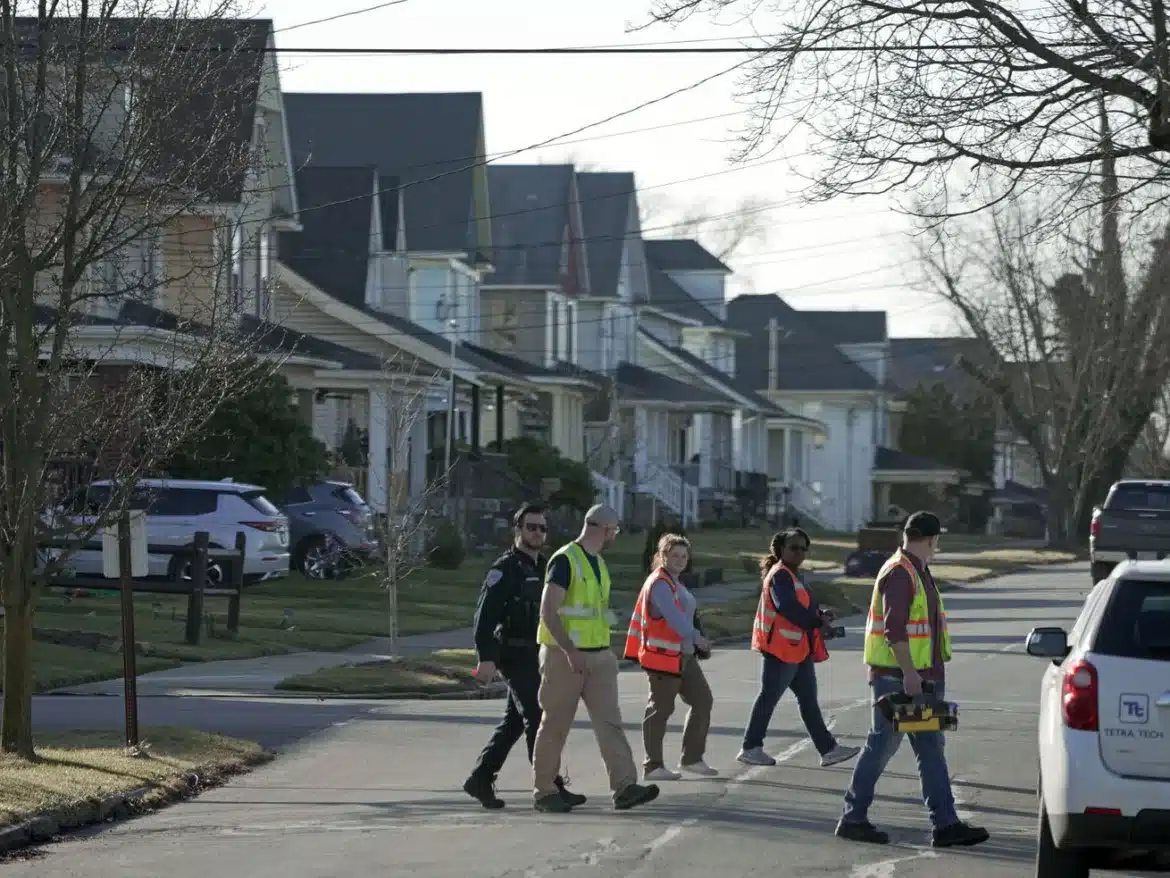Long after the disaster, residents of East Palestine still fear for their safety.
Editor’s note, April 9, 1:15 pm ET: On April 9, the Norfolk Southern railway company announced that it agreed to pay $600 million to settle a class-action lawsuit stemming from a February 2023 derailment of a train carrying hazardous materials in East Palestine, Ohio. The derailed train was carrying a variety of toxic chemicals, including vinyl chloride, which is used to make plastics.
When the train derailed last year, hundreds of people were evacuated. Today, many residents remain concerned about contamination and say they do not trust the assurances they have received from Norfolk Southern; Norfolk Southern didn’t admit to any liability or wrongdoing as a result of the settlement. The settlement, which still needs to be approved by a district judge, will be used in part to support upgrades to drinking water infrastructure, community-directed projects, and economic development.
The following article, published in March 2023 in the wake of the derailment, explains the fears that continue to preoccupy thousands of East Palestine residents. —Paige Vega, climate editor
EAST PALESTINE, Ohio — The smell doesn’t hit you right away. On Market Street, the main commercial road in town, it smells of doughnuts and McDonald’s and exhaust. It’s only when the wind picks up, or you walk toward the western edge of town, that you can catch a whiff of the chemicals.
Some say they smell like nail polish remover or super glue. To me, the odor was sweet, like a cheap fruity air freshener, with a bitter aftertaste.
It has been over a month since a large train derailed here, sending up flames taller than buildings and spewing more than 100,000 gallons of toxic chemicals into the environment. Federal and local officials have been trying to clean up the mess. And for weeks, they’ve been assuring residents that the air and water are safe, according to monitoring. It won’t put the health of residents at risk, health officials have repeatedly said.
Yet for many of them, East Palestine, a village of roughly 4,700 people, still doesn’t feel safe at all.
You can’t blame them. In some parts of town, the scent of chemicals still hangs in the air. You can see pollution in the streams, which appears as an iridescent sheen on the water’s surface. Independent analyses complicate the scientific side of the story. Meanwhile, a large number of people have been complaining of headaches, coughing, and other symptoms in the wake of the derailment. This has many residents asking: How can East Palestine really be safe?
/cdn.vox-cdn.com/uploads/chorus_asset/file/24484001/IMG_0223.jpeg)
Courtesy of Sam Hall
And for some locals I talked to, East Palestine will never feel safe again — even as the smells dissipate, the creek clears up, and the throngs of neon-vested officials return home. East Palestine has been permanently tainted for them. “Feel safe in East Palestine? I don’t think it’s going to happen,” Wayne Bable, a retired mechanic who’s lived in town for the last three decades, told me one morning last week.
Making a place feel safe after an environmental disaster like this is not just about analyzing the air and water, psychologists and risk communication experts said. Peace of mind requires building trust between residents and public officials and understanding that a sense of safety is rooted in feelings, emotions, and experiences — not just in data.
That trust has been lost in East Palestine. And it’s far from the first case of environmental contamination to undermine faith in public services (see: Flint, Michigan). So, what can we learn this time?
The unsurprising reasons residents still don’t feel safe in East Palestine
The smell of chemicals worsens as you approach Brushville Supply, a store on the eastern edge of town that sells hoses, sanders, and other tools. It’s just over 500 feet from the tracks and in eyeshot of where the train derailed. I could see some of the derailed cars from a hill just outside the shop.
“I get headaches every time I come over here,” said Austin Huffman, who works at Brushville Supply, his family’s business. “During the weekends, it goes away.”
There is a strong scientific case that the air and water are safe in East Palestine. Many of the chemicals that spilled into the environment, such as vinyl chloride, can indeed be dangerous, but testing of indoor and outdoor air quality has consistently indicated that they’re not present in harmful quantities. The same is true for the village’s drinking water.
But that doesn’t match the experience of Huffman and other residents. Medical professionals recently surveyed 168 East Palestine residents who visited a local health clinic, and nearly three-quarters of them reported having headaches in the wake of the wreck. More than half of them reported coughing or skin irritation.
The enormous gulf between official statements and how people are feeling is one reason why the dozen or so residents I talked to simply don’t trust anything public health officials are saying. Further eroding that trust (and adding confusion) are results from independent air quality testing that detected levels of a potentially harmful chemical called acrolein that “occasionally rose above safety thresholds for long-term health concerns.”
Another daily reality making residents feel unsafe is what they’re seeing in the water.
One afternoon last week, I visited Bable’s property south of town, which is situated adjacent to a creek called Leslie Run that snakes through East Palestine. Using a hoe, Bable turned over a large rock in the stream. A rainbow slick bloomed on the surface. Those are chemicals from the derailment, Bable said. (I wasn’t able to verify that those iridescent slicks were chemicals, but they align with similar reports.)
This creek is normally teeming with minnows and crayfish, Bable told me, as he continued to pick up rocks. We didn’t see any. “They’re all dead,” he said, as a result of the spill. So far, wildlife officials estimate that the chemical spill has killed more than 43,000 aquatic animals including fish, frogs, and crayfish.
/cdn.vox-cdn.com/uploads/chorus_asset/file/24485790/IMG_1916.jpg)
Benji Jones/Vox
These visual cues that residents are witnessing are incredibly powerful in shaping the perception of risk, according to Paul Slovic, a risk psychologist at the University of Oregon. “People are responding to their senses,” he said. “The smell is bad, there’s stuff in the water. That creates a feeling of vulnerability, of exposure, or lack of safety.”
Some locals see East Palestine as permanently tainted
As spring carries on, the stench of chemicals in the air will continue to subside. The fish will likely return to the creeks (I saw a small school of minnows far downstream). More complete chemical testing is likely to continue to indicate that the environment is free of harmful levels of contaminants.
Nonetheless, some residents may never feel safe. Wayne Bable’s wife, Gail, has resided in East Palestine for more than four decades. They live about a mile and a half from the derailment, though she can see the train tracks from her kitchen window. “I’ve been up since 3 o’clock in the morning listening to the trains go by,” she said.
Gail says she won’t feel fully safe unless she moves out of town. Nearly everyone I spoke to knew at least one person who moved away and doesn’t plan to come back. (Gail and Wayne own three properties in the region, which makes it hard to just pick up and leave, she said.)
/cdn.vox-cdn.com/uploads/chorus_asset/file/24487063/AP23059720756759.jpg)
AP
East Palestine is a conservative town; you can see Trump signs everywhere. In the 2020 election, the former president won nearly 72 percent of the vote in East Palestine’s Columbiana County. That could influence their feelings of safety: Polling data shows that Republicans have very little trust in the federal government, compared to Democrats (though neither political party reports feeling a large amount of trust.)
“I don’t trust our government,” Wayne Bable said. “I will never trust our government.”
But regardless of someone’s politics, Slovic said, their sense of safety often has more to do with feelings and emotions than it does any data analysis. That’s why more scientific data may not return the sense of safety to town.
“Risk exists in us mostly as a gut feeling, not as a calculation,” he said. “They feel that their community is contaminated. When you have that image in your mind — of contamination — you can’t be comfortable. People are relying on thoughts and feelings that are very hard to get rid of.”
A better way to deal with environmental disasters
It’s hard for residents to feel safe after a severe environmental disaster like this, no matter how public officials respond. But critics say that those officials also made mistakes that sowed distrust — mistakes that we can learn from.
A few days after the train wreck, Ohio officials ordered many East Palestine residents to evacuate before burning off a large amount of vinyl chloride that they said was at risk of exploding. The controlled burn created an apocalyptic scene: a giant tower of thick, dark smoke rising above the village.
Just two days later, Ohio Gov. Mike DeWine announced, along with the local fire chief, that residents could safely return home. Air quality monitoring, he said, didn’t detect harmful levels of pollution in the air around the derailment.
/cdn.vox-cdn.com/uploads/chorus_asset/file/24485816/AP23037806695053.jpg)
Gene J. Puskar/AP
That announcement — that it’s completely safe — made some residents suspicious and untrusting of health officials.
The decision was based on preliminary testing, which many residents and outside experts consider incomplete. Some scientists have also questioned whether those early tests were sensitive enough to capture low quantities of chemicals that could be harmful, especially when present alongside a melange of other compounds. And again, people were experiencing a range of symptoms when they returned home, including headaches.
One problem was that the announcement lacked nuance and transparency, according to James Fabisiak, a toxicologist and public health expert at the University of Pittsburgh. It wasn’t clear what officials knew and what they didn’t, and what that might mean for residents. Transparent communication is essential following any environmental disaster, added Ellen Peters, a decision psychologist and communications expert at the University of Oregon.
“Treat people respectfully as adults who can make decisions in their own lives,” Peters said. “People are being patted on the head and told everything is fine, [but health officials] haven’t provided enough information for people to believe that it’s fine. To discount what it looks like compared to what the experts presumably believe doesn’t go over well with people.”
Daniel Tierney, a spokesperson for Gov. DeWine, told Vox that claims that the February 8 announcement lacked transparency are “hogwash.” The decision was ultimately made by the East Palestine fire chief, Tierney said, though the governor agreed with it. There were air and water experts available to address questions at the press conference, he said.
Tierney confirmed that the testing prior to the announcement was preliminary, though he said that “we’ve never had a test that’s come back [since] with any level of concern for short-term exposure.” Tierney said that the tests were sensitive enough to detect chemicals at levels of concern in the short term.
Following a disaster like this, it’s also important to give residents plenty of opportunities to voice their concerns and include them in the decision-making process, said Alison Adams, an environmental risk expert at the University of Florida. Communication should be flowing both ways, not just from public officials to residents, she said.
The challenge now facing public officials in East Palestine is building back trust. Better communication can help, experts say, but it probably won’t go far enough to reinstate a feeling of safety. Perhaps, Slovic says, officials can give residents access to independent experts who have their interests at heart and can carry out independent testing. “That’s the only hope for this,” he said.
Ultimately, disaster response needs to extend beyond cleaning up chemicals, Slovic said. Officials should be more mindful about the communication of risk and the psychology of residents. “There’s a need to integrate the psychology and sociology here with the scientific analysis,” Slovic said. “You can’t divorce the two.”
Eventually, the feeling of safety may return to residents who’ve lost it, without much intervention. People will follow their senses, Peters said. “What they hopefully are going to start to see is that things are getting cleaned up, that things are starting to look more like normal, that their headaches are going away,” she said, and “that other people are saying, ‘I feel okay.’”

/cdn.vox-cdn.com/uploads/chorus_asset/file/24483993/IMG_9954.jpeg)
/cdn.vox-cdn.com/uploads/chorus_asset/file/24483989/IMG_9932.jpeg)


